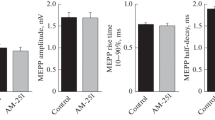We examined the mechanisms of NO action on transmitter release in neuromuscular preparations of the mouse diaphragm muscle using a standard microelectrode technique. A donor of NO (SNAP, 100 μM) and a substrate for NO synthesis (L-arginine, 100 μM) reduced the evoked transmitter release from motor nerve endings. At the same time, SNAP did not change the frequency and amplitude of miniature end-plate potentials, while an inhibitor of NO synthase, L-NAME, exerted no effect on evoked and spontaneous transmitter release. Inhibition of soluble guanylate cyclase by ODQ (2.5 μM) abolished the effect of NO on the evoked transmitter release, while the elevation of cGMP-level by its membranepenetrating analog 8BrcGMP did not prevent such effect. The elevation of intracellular concentration of cAMP by 100 μM of its analog 8(4CPT) cAMP or inhibition of phosphodiesterase (PDE) by the action of 100 μM IBMX eliminated NO effects on transmitter release. It is concluded that NO activates soluble guanylate cyclase and intensifies the cGMP synthesis. Activation of the PDE II via an increase in the cGMP level with consequent reduction of the level of intracellular cAMP and decrease in the activity of PKA reduced transmitter release from mouse motor nerve ending.
Similar content being viewed by others
References
S. R. Vincent, “Nitric oxide neurons and neurotransmission,” Prog. Neurobiol., 90, No. 2, 246–255 (2010).
J. Garthwaite, “Concepts of neural nitric oxide-mediated transmission,” Eur. J. Neurosci., 27, 2783–2802 (2008).
G. F. Sitdikova and A. L. Zefirov, “Gasotransmitters in regulation of neuromuscular transmission,” in: Gasotransmitters: Physiology and Pathophysiology, A. Hermann et al. (eds.), Springer (2012), pp. 139–161.
A. V. Yakovlev, G. F. Sitdikova, and A. L. Zefirov, “Role of cyclic nucleotides in mediating the nitric oxide (II) effects on transmitter release and the electrogenesis of motor nerve endings,” Dokl. Biol. Sci., 382, 11–14 (2002).
C. R. Ambiel and W. Alves-Do-Prado, “Neuromuscular facilitation and blockade induced by L-arginine and nitric oxide in the rat isolated diaphragm,” Gen. Pharmacol., 28, 789–794 (1997).
А. Barroso, L. Oliveira, E. Campesatto-Mella, et al., “L-citrulline inhibits [3H]acetylcholine release from rat motor nerve terminals by increasing adenosine outflow and activation of A1 receptors,” Br. J. Pharmacol., 151, 541–550 (2007).
T. J. Nickels and G. W. Reed, “Does nitric oxide modulate transmitter release at the mammalian neuromuscular junction?” J. Physiol., 32, 318–326 (2007).
L. L. Kusner and H. J. Kaminski, “Nitric oxide synthase is concentrated at the skeletal muscle endplate,” Brain Res., 730, Nos. 1/2, 238–242 (1996).
M. A. Castellano, D. Rojas-Díaz, F. Martín, et al., “Opposite effects of low and high doses of arginine on glutamate-induced nitric oxide formation in rat substantia nigra,” Neurosci. Lett., 314, 127–130 (2001).
G. F. Sitdikova, A. V. Yakovlev, A. L. Zefirov, and O. V. Arkhipova, “The effects of L- and D-stereoisomers on the transmitter secretion and ion currents in the motor nerve ending,” Dokl. Biol. Sci., 393, Nos. 1/6, 523–526 (2003).
D. S. Bredt, “Nitric oxide signaling specificity – the heart of the problem,” J. Cell Sci., 116, No. 1, 9–15 (2003).
S. Seino and T. Shibasaki, “PKA-dependent and PKAindependent pathways for cAMP-regulated exocytosis,” Physiol. Rev., 85, 1303–1342 (2005).
A. V. Yakovlev, G. F. Sitdikova, and A. L. Zefirov, “Intracellular mechanisms of presynaptic effects of nitric oxide (II) in neuromuscular junction of the frog,” Neurochemistry, 22, 81–87 (2005).
D. T. Lin, P. Fretier, C. Jiang, and S. R. Vincent, “Nitric oxide signaling via cGMP-stimulated phosphodiesterase in striatal neurons,” Synapse, 64, No. 6, 460–466 (2010).
M. O. Velardez, A. De Laurentiis, M. C. del Carmen Diaz, et al., “Role of phosphodiesterase and protein kinase G on nitric oxide-induced inhibition of prolactin release from the rat anterior pituitary,” Eur. J. Endocrinol., 143, 279–284 (2000).
Author information
Authors and Affiliations
Corresponding author
Rights and permissions
About this article
Cite this article
Valiullina, F.F., Sitdikova, G.F. Effects and Mechanisms of Action of Nitric Oxide on Transmitter Release in Mouse Motor Nerve Terminals. Neurophysiology 44, 490–492 (2012). https://doi.org/10.1007/s11062-012-9324-7
Received:
Published:
Issue Date:
DOI: https://doi.org/10.1007/s11062-012-9324-7




